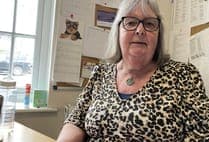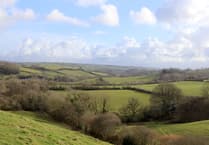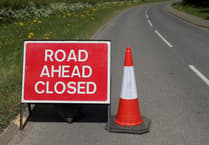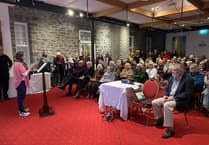THE story of a RAF Liberator and its crew that crashed into farmland at Plaster Down during the Second World War inspired a man from Grenofen to write the story of the wartime tragedy in his fascinating book on Dartmoor Air Crashes.
Robert Jones, aged 73, said he first read about the air crash when he read an article on it by Nigel Rendle of the Yelverton History Society and was amazed to discover that the crash had taken place on October 30, 1942 —when he, himself, was just one day-old and born in nearby Plymouth.
He told the Times: ‘I do feel it is important to remember their courage and the sacrifice that each of the men made. Perhaps in the greater story of the war it was a small incident but it is nevertheless one which took place on our doorstep and is part of our local history.
‘It is important to highlight their story and remember those airmen who made the utimate sacrifice.’
The following is an extract from the book:
Tragedy at Plaster Down
In the autumn of 1942 preparations were underway for Operation Torch, the Allied invasion of North Africa. Convoys of ships carrying troops and equipment were making their way slowly across the Bay of Biscay under the protection of aircraft of RAF Coastal Command that circled overhead.
In October 1942, 224 Squadron RAF was part of Coastal Command. Based at Beaulieu on the edge of the New Forest, it was equipped with American built Consolidated Liberator 3A bombers.
Each aircraft had a letter painted on the fuselage to identify it. One of them, serial number FK242, bore the letter K, giving it the call sign ‘King’.
On October 30 at 8.30am K ‘King’ took off from Beaulieu with a crew of seven on board. Their task was to escort the ships transporting troops and equipment for Operation Torch. They spent a long day keeping watch for enemy submarines and reconnaissance aircraft.
The Liberator could carry enough petrol for 14 hours flying, but after it had been airborne for ten hours, a distress signal was received reporting there was only 30 minutes of fuel left.
On the way back to Beaulieu it had struck a barrage balloon cable over Plymouth. The damage was serious and the bomber was diverted to land at Harrowbeer by Yelverton.
But the runways had been built for fighters and were not long enough for bombers. Nevertheless, the duty watch at Harrowbeer was warned a Liberator was approaching for an emergency landing. There was little they could do to help; no sooner had they been made aware of it, the damaged aircraft arrived over the airfield. It was pitch-dark and there were no runway lights. Now very low on fuel, the situation with K ‘King’ was getting desperate.
Those at Harrowbeer watched helplessly as the Liberator, hampered by low cloud, made two circuits of the airfield before disappearing to the north. Unbeknown to them, the aircraft had come down in a field two miles away. In view of the distress signal, it had almost certainly run out of fuel. But if those at Harrowbeer did not know what had happened, the residents of Fullamoor Farm by Plaster Down would have been all too aware as the four engine bomber struck the ground barely a 100 yards from the farmhouse.
There was nothing the pilots could do as the aircraft ploughed across the field to smash into a stone hedge bank. The crash would have been horrendous and of the crew of seven, six of them died. Miraculously there was one survivor, although he was seriously injured.
Apart from tending to the injured airman, nothing could be done for the rest of the crew. The next day their remains were taken to the mortuary at RAF Harrowbeer.
As with many, the crew of K ‘King’ came from all walks of life and from different parts of the globe. All were volunteers, but what is striking was the age of those who made the ultimate sacrifice.
The crew of the Liberator
Flying Officer Gavin Sellar, RAFVR, aged 21, was the first pilot and captain. The husband of Jean Sellar of Harpenden, he went to school at Charterhouse and was a scholar of Trinity College, Cambridge. He is commemorated at Bournemouth Crematorium.
Sergeant Harry Dawe, RAFVR, aged 27, was the co-pilot. The husband of Edith Dawe of Wallasey, he is buried in Rake Lane Cemetery, Wallasey.
Flying Officer Victor Crowther, Royal New Zealand Air Force, aged 24, was the navigator. From Christchurch, New Zealand, he is buried in Buckland Monachorum Cemetery.
Sergeant William Fraser, RAFVR, aged 24, was the flight engineer. From Newton Mearns in Renfrewshire, he is buried in Buckland Monachorum Cemetery.
Pilot Officer William Martin, RAFVR, aged 26, was a radio operator/gunner. From Shawlands in Glasgow, he was the husband of Joan Martin from Bristol; they had recently married. He is buried in Buckland Monachorum Cemetery.
Pilot Officer William A Cruickshanks, RAFVR, age unknown, was a radio operator/gunner. He had only joined the squadron two days before.
In 1943 he received a ‘mentioned in despatches’ for service with his previous unit. Originally from North Shields, he is buried in Preston Cemetery, Tynemouth.
Sergeant Dennis Pass, RAFVR, aged 20, was the rear gunner. From Grimsby, he was the sole survivor although he suffered serious injuries. He had been helped from the wreckage by Henry Walsh, a young evacuee from Plymouth who was staying at Fullamoor Farm.
With the engines starved of fuel, the Liberator had swooped low over Plaster Down and struck a line of trees before careering across the field and into the bank.
The impact created a gap in the hedge that led to a gate being put there.In 1983 a memorial plaque was placed on one of the gate posts by Dennis Pass, the surviving crewman. He was accompanied by his wife and his rescuer Henry Walsh.
The lettering is now almost illegible and the citation has a slight inaccuracy; the date given for the crash is wrong by a day.
Having survived the crash on Dartmoor, Dennis Pass recovered from his injuries and returned to operational flying.
Amazingly he was to survive another crash in a Liberator, which happened in Burma two years later. He died peacefully in hospital at Grimsby in February 2015 – he was 92.
Henry Walsh, the rescuer on that fateful night in 1942, had died at Plymouth in 2000.
In accordance with his wishes, his ashes were scattered where Liberator K ‘King’ had come to rest.
New memorial
More than 70 years after the tragic event, there is a plan to replace the badly worn plaque. Relatives of the airmen are looking to put a permanent memorial on the edge of Plaster Down in memory of the crew of Liberator K ‘King’.
After being asked by some of the family of the crew of the aircraft if it was possible to replace the worn memorial plaque at the site of the crash at Fullamoor Farm at Plaster Down. Mr Jones is hoping that in the future this will be done. Currently a worn sign, erected in 1983 stands on private land with no right of access. Mr Jones hopes the Dartmoor National Park Authority will allow a replacement memorial on the open moor nearby.




